The Kwangtung turtle is critically endangered and in need of conservation efforts.
Mauremys nigricans, a remarkable Asian species related to the popular Reeves’ turtle (Mauremys [Chinemys] reevesii), has had a recent surge in interest and demand by hobbyists around the world. Sometimes called the red-necked pond turtle, black-necked pond turtle or dumb-head turtle, M. nigricans is most commonly called the Kwangtung turtle or the Kwangtung river turtle in the United States. In older literature, it is referred to by the scientific name Chinemys kwangtungensis.
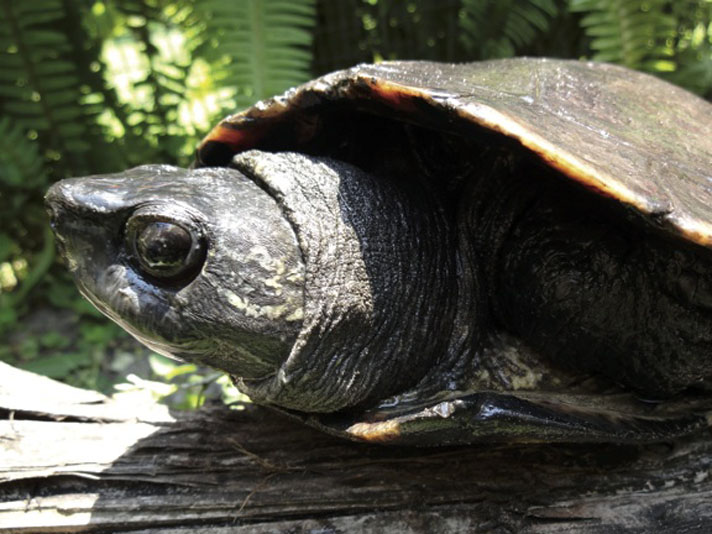
PAUL VANDER SCHOUW
Mauremys nigricans is highly adapted to a basking lifestyle, so it is also very important for turtles to be able to dry thoroughly.
Known historically from Guangdong (formerly spelled Kwangtung) and Guangxi provinces in southern China, recent records suggest this turtle may also occur in Fujian and Hainan, China, and northeastern Vietnam. It may be that these recently discovered localities are the result of human introductions from nearby live animal markets. This is a primarily subtropical geographic range, with hot summers and no appreciable difference between the wet season and dry season. Montane streams and associated pools are the Kwangtung turtle’s preferred habitat. Muscular limbs and fully webbed feet make M. nigricans a strong swimmer in the moving water where it reportedly occurs.
Mauremys nigricans is listed as Critically Endangered on the IUCN (International Union for Conservation of Nature) Red List, meaning that it faces an extremely high risk of extinction in the near future. Within its native range, collection by humans presents the primary threat to the Kwangtung turtle. In previous decades, this species was captured incidentally in traps set for highly sought-after species, such as Cuora trifasciata. More recently however, it seems that M. nigricans has become more valued by collectors, and population surveys as recent as 2009 failed to locate the species in its historic habitat. The species is protected from collection in China. While it is difficult to curtail poaching from the wild, there is some hope that the increasing regularity of captive breeding will help alleviate some of the pressures on any remaining wild populations.
Kwangtung Turtle Look and Coloration
Kwangtung turtles exhibit strong sexual dimorphism—that is, marked differences between males and females—not only in adult size and shape, but also in coloration. In both sexes, the carapace is dark brown to black, with little or no pattern. Adult females normally have narrow white, cream or yellow lines on the sides of their heads. Some females develop enlarged heads as they age, a condition referred to as macrocephaly or megacephaly, and their head pattern fades as well. On the other hand, males can become vividly colored. Many will develop extensive areas of yellow, orange or pink/red along the sides of the head, shoulders, legs and tail that expand with age and intensify with the onset of the breeding season.
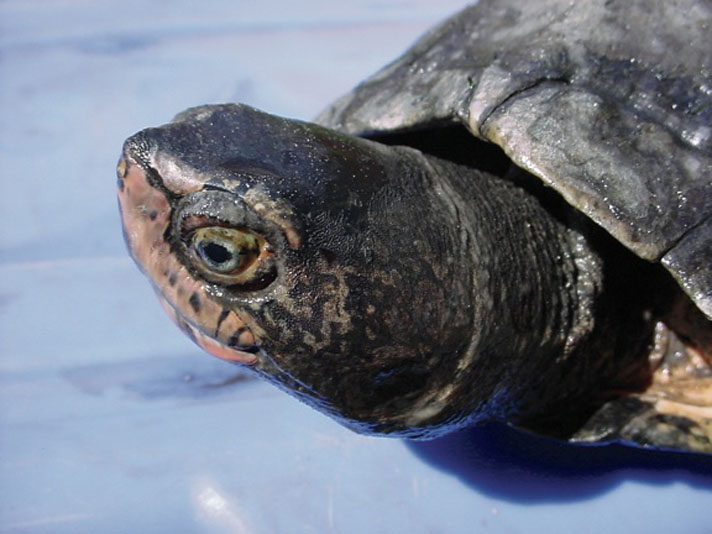
paul vander schouw
Only the male Kwangtung turtle bears coloration beyond the basic brown and black. Some exhibit yellow or orange, or pink and red, as with this specimen.
The plastral pattern of both sexes varies considerably from one individual to another, with irregular patches of dark brown to black on a lighter background. Males’ plastrons are also frequently tinted with orange or pink, and appear flatter or even slightly concave compared to that of females. As with most turtle species, the male’s tail is proportionally longer and thicker than the female’s. In both sexes, the shell profile is of moderate depth, but some individuals can be somewhat flattened. The marginals are blunt along the front and sides of the shell, while the rear marginals are barely flared.
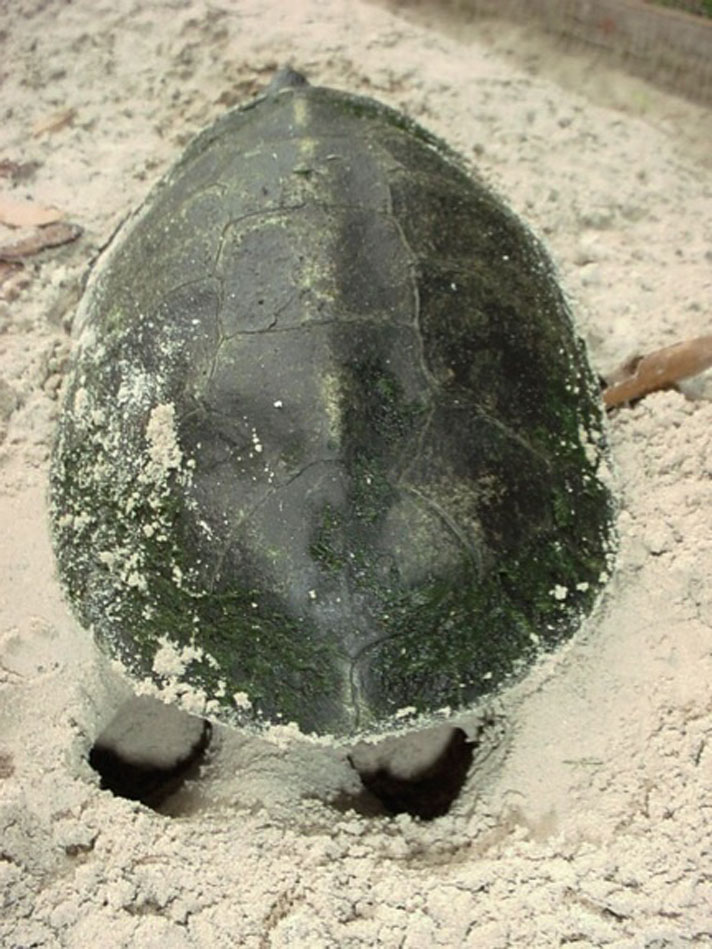
PAUL VANDER SCHOUW
This female is in the process of digging a typical dual-chambered nest. She will distribute her eggs roughly equally between the two cavities.
Upon hatching, the shell of the Kwangtung turtle bears a moderate medial keel and weak lateral keels. The tails of hatchlings are long. The surface texture of the carapace is rough, but this gradually smoothes with growth, as does the prominence of the keels and tail length in relation to body size. The most striking feature of hatchling Kwangtung turtles is their coloration: they are typically jet black dorsally, but bright orange to deep red with black spots or blotches ventrally. Unfortunately, this remarkable coloration fades quickly as the turtle grows.
Hatchling turtles average around 1½ inches in carapace length. They grow rapidly and are capable of reaching 4 inches in their first year, but slower growth is the norm. To a large degree, the growth rate can be controlled by the amount of food offered to growing turtles and the temperature at which they are maintained. The more food the turtle is fed and the warmer it is kept, the faster it will grow. Similar to many other turtle species, sexual maturity is a function of size rather than age. Gender can typically be discerned at approximately 3 inches carapace length, but maturity is not attained until about 4 inches in males and 6 inches in females. Maximum size for males is roughly 7 inches, while females are capable of reaching up to almost 12 inches. Captives have been documented to live for at least 25 years, and 50 years or more is likely under optimum conditions.
Kwangtung Turtle Captive Care
In captivity, M. nigricans is fairly easy to maintain. At a minimum, five items will be required to provide them a safe, healthy captive environment: a secure, suitably-sized container; a sturdy basking platform that allows the turtle to emerge from the water and dry completely; a good full-spectrum light source; temperature control for air and water within the tank; and a nutritious diet.
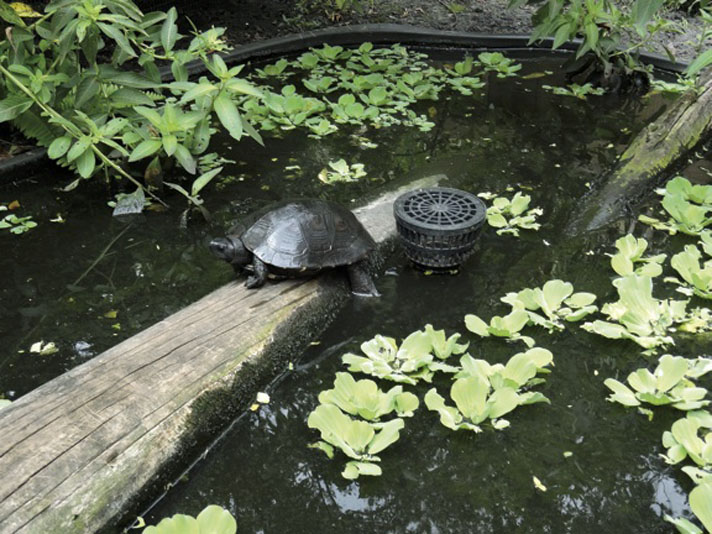
PAUL VANDER SCHOUW
With her days as a beautiful, vivid hatchling all but a memory, this female is still impressive with her large size and proportionately massive head.
Hatchlings can be maintained in virtually any container with a minimum volume-to-size ratio of 10 gallons per inch of turtle for a single animal, and water depth no less than 1½ times the straight length of the turtle’s shell. For each additional animal, an additional 5 gallons of water volume per inch of turtle should be provided. Glass tanks work well, as do sweater boxes and similar durable plastic storage bins. Stock tanks are highly recommended, especially for larger turtles. Considering the rule-of-thumb above, a 10-inch adult female will require no less than 100 gallons of tank space! A breeding group of one 6-inch male and two 10-inch females would need at least 150 gallons. However, some males must be maintained separately from females due to unrelenting and aggressive breeding behavior.
Tank furnishings should be appropriate to the size of the turtles and tank in which they are housed. Small turtles can accept smaller basking accommodations, but never underestimate the ability of even the smallest turtle to destabilize piles of stones or driftwood. The results can be disastrous! Turtles can easily pin themselves under shifted rock and wood, or get trapped underwater by narrowed openings in hide holes and caves. Glass tanks can also be cracked or smashed outright by a shifting stone or log, so the utmost care should be taken to prevent potential catastrophes. Mauremys nigricans is highly adapted to a basking lifestyle, so it is also very important for turtles to be able to dry thoroughly, from the tip of the nose to the tip of the tail. Allowing the turtle’s skin to dry completely will aid in its shedding, and prevent bacterial and fungal infections that can sicken or even kill the turtle.
There are many excellent brands of full-spectrum lighting available commercially. The key is to select a bulb that will provide not only UVA wavelengths, but UVB wavelengths, as well. UVB is the portion of the spectrum that allows the turtle’s skin to synthesize vitamin D3, and this is essential for the turtle’s system to metabolize calcium. Ambient temperature and any other temperature control devices being used will determine whether fluorescent or incandescent bulbs are appropriate. Fluorescent bulbs, characteristically, generate considerably less heat than incandescent bulbs, and their use typically necessitates an additional heat source for basking. Be sure to suspend any UVB bulb at least the minimum distance from the basking surface plus the height of the turtle, as recommended by the manufacturer.
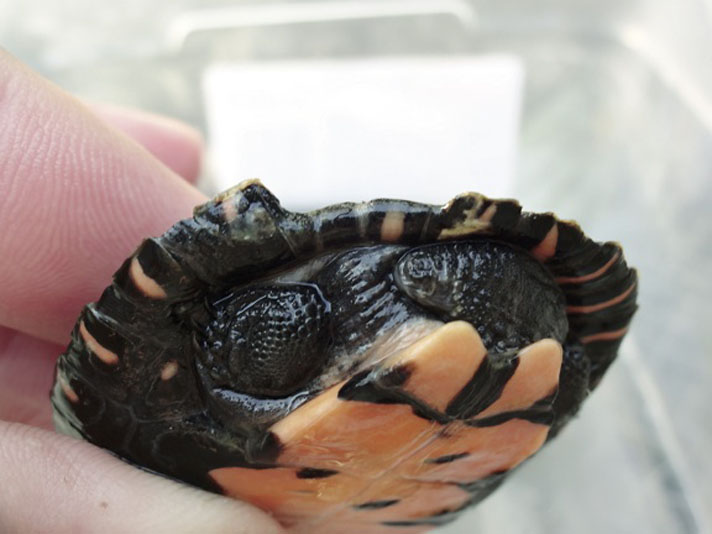
PAUL VANDER SCHOUW
This turtle’s rear marginals and tail were nipped by a larger tankmate. While the damage will heal and the injured turtle can go on to live a perfectly normal life, this situation is easily avoided by not mixing larger turtles with smaller ones.
Despite their apparently narrow natural distribution, Kwangtung turtles are tolerant of a wide range of temperatures. In general, water temperatures ranging from 75 to 80 degrees Fahrenheit, air temperatures from 75 to 85 degrees, and basking temperatures between 85 and 90 degrees should result in healthy, active turtles. Submersible titanium heaters with plastic safety or anti-burn guards, and spot lamps, including incandescent bulbs as mentioned previously, can be used in combination to produce the suitable temperature range. The basic idea is to achieve a thermal gradient with the coolest temperature in the water, to mid-range temperatures in the adjacent air, to the warmest temperature under the basking spot. Turtles will become sluggish in cold water, but this species does not truly hibernate and should not be exposed to particularly low winter temperatures, especially when young.
Although their natural diet is unknown, captive M. nigricans will consume practically any type of food they are offered, whether it is vegetable or animal in nature. Their broad, muscular heads with powerful jaws suggest an adaptation to mollusks or hard fruit, but captive specimens will seldom turn their noses up at anything. Even new hatchlings will generally accept commercial pelleted food for their first meal. As with any omnivorous turtle species, however, care should be taken to ensure a balanced diet with roughly 30- to 40-percent protein content, high calcium/low phosphate, and a wide variety of vitamins and minerals is provided. Fat content of all food should be low (below 3 percent is best for adults). Excess fat in the diet can cause skin above the hind legs to balloon in adults. Romaine lettuce, water lettuce or hyacinth, and duckweed can also be left floating in the water for the turtles to nibble at their leisure. Kwangtung turtles kept in outdoor enclosures will routinely graze on grass and weeds, especially at night.
Important Consideration When Choosing a Kwangtung Turtle
When selecting a Kwangtung turtle, there are several points to consider. As already mentioned, this species is in serious trouble in its native range and this point cannot be overemphasized. With that in mind the first selection criterion should be to select captive-bred turtles over wild-caught. Additionally, captive-bred turtles are generally healthier and better acclimated to life in captivity, and they are less likely to harbor diseases that could infect an existing collection. The preference for captive-bred animals should be straightforward given that the species is no longer imported into the United States. All available young Kwangtung turtles are almost certainly captive bred.
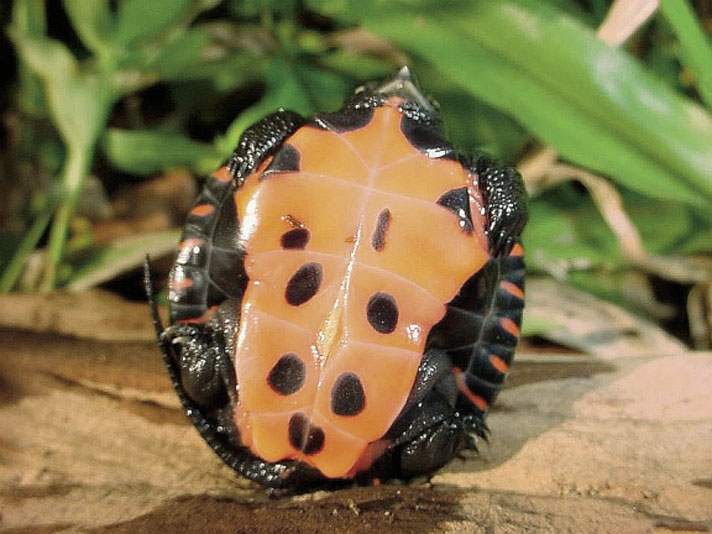
PAUL VANDER SCHOUW
The colorful plastron is a striking contrast to the subdued view from above.
Kwangtung Turtle Breeding
Courtship and breeding in this species is fairly straightforward and occurs entirely under water. The male will often pursue the female from the rear, sniffing around her rear legs and tail while swimming behind her. He will then approach the female from the front, rapidly extending and retracting his head. If the female is receptive, she will extend her hind legs so that her rear end is elevated. The male then mounts her from behind, biting her head and neck throughout copulation. Courtship and breeding follow seasonal patterns, peaking in late winter and early spring.
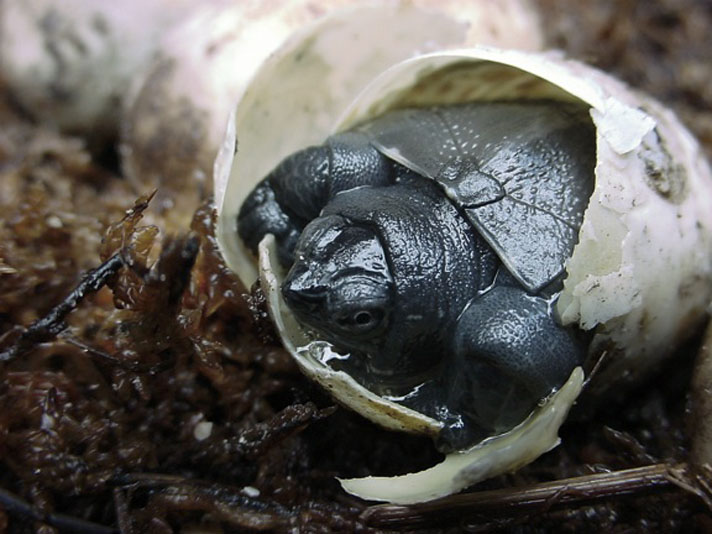
PAUL VANDER SCHOUW
A new life begins. The eggs of the Kwangtung turtle possess a parchment-like membrane encased in a thin, brittle shell.
Kwangtung turtle females can be prolific, producing up to four clutches of four to 13 eggs per season, with an average of two clutches of about eight eggs. However, clutch size does decrease from the season’s first clutch to the last. Female M. nigricans are unique among Asian turtle species in that they typically dig two separate nest cavities, side-by-side, using alternating scoops of their hind feet. Clutches are generally divided more or less evenly between the two nest cavities. Larger females produce larger clutches of larger eggs as might be expected, with average egg size being roughly 1½ inches long by three-fourths of an inch wide. Eggshells are thin and brittle with a more flexible parchment-like membrane beneath.
Eggs are produced throughout spring and summer, starting in early May and running on through early August in the northern hemisphere. Conventional wisdom holds that the sex of this species is influenced by incubation temperature, and research is currently underway to verify this. Hatching success is greatest when eggs are incubated at 80 to 86 degrees Fahrenheit and 80-percent relative humidity in damp sphagnum moss. Vermiculite has also been used to successfully incubate eggs.
Kwangtung Turtle Cohabitation
Kwangtung turtles can make excellent cohabitants in community turtle tanks. Their temperament is generally passive toward other species, and their behavior is comparable to American cooters and sliders (Pseudemys and Trachemys) in many respects. As with any community housing arrangement for turtles, it is strongly recommended that the largest turtle is not more than twice as large as the smallest turtle in the tank. This will limit the potential for injuries, especially during feeding time.
One point that definitely warrants emphasis is this: The disproportionately long tail of the hatchling and juvenile Kwangtung turtles seem to be irresistible to fellow hatchling M. nigricans and other species alike. It is rare for a young Kwangtung turtle to reach 4 inches in length without having some portion of its tail bitten off in the company of other turtles, but this tail nipping rarely results in severe injury. Moreover, by the time the turtle reaches maturity it may be practically impossible to tell that nipping has ever occurred. Overall, the Kwangtung turtle is an interesting and undemanding species for the hobbyist. Given the proper care and attention, this charming turtle can be a gratifying and enjoyable captive for decades.
PAUL VANDER SCHOUW is an avid turtle hobbyist from west-central Florida. A mechanical engineer by profession, he has about 1,000 individual turtles representing more than 100 species and subspecies. He has successfully bred more than half. Chelid side-necked turtles are his primary interest.



